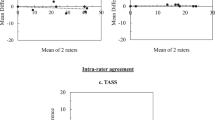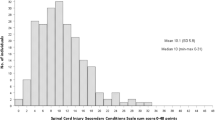Abstract
Study design:
This is a Delphi study.
Objectives:
Defining variables that potentially influence the outcomes of an animal study regarding pathophysiology of traumatic spinal cord injury (TSCI).
Setting:
This study was conducted in Iran.
Methods:
A modified two-round Delphi study was conducted. As the first round, an initial questionnaire was developed on the basis of literature and a series of focus group discussions. In the second round, the participants were asked to score the items through a 10-point scale. Consensus was achieved through the following criteria: (1) the median of scores has to be at 7.5 or higher, and (2) at least 70% of participants need to rate 7 or higher. Also, the inter-rater reliability analysis was performed to determine consistency among raters using the Kappa coefficient and Cronbach's alpha.
Results:
Twenty-one experts participated in our study. From the first round of the study, a 47-item checklist was developed. By considering the aforementioned criteria for consensus building on extremely important factors, we reached a 15-item checklist including species, strain, method and level of injury, control group, genetic background, severity of injury, attrition, use of appropriate test, blindness, method of allocation to treatments, regulation and ethics, age/weight, bladder expression, number of animals/group and statistics. The inter-rater reliability for the raters was found to be Kappa=0.82 (P<0.001). A Cronbach's alpha of 0.9 for all the questions indicated high internal consistency.
Conclusion:
This study introduces a checklist of variables that potentially influence the outcomes of animal studies regarding TSCI pathophysiology and describe its validity and reliability.
Similar content being viewed by others
Log in or create a free account to read this content
Gain free access to this article, as well as selected content from this journal and more on nature.com
or
References
Saadat S, Javadi M, Divshali BS, Tavakoli AH, Ghodsi SM, Montazeri A et al. Health-related quality of life among individuals with long-standing spinal cord injury: a comparative study of veterans and non-veterans. BMC Public Health 2010; 10: 1–7.
Eslami V, Saadat S, Habibi Arejan R, Vaccaro AR, Ghodsi SM, Rahimi-Movaghar V . Factors associated with the development of pressure ulcers after spinal cord injury. Spinal Cord 2012; 50: 899–903.
Rahimi-Movaghar V, Moradi-Lakeh M, Rasouli MR, Vaccaro AR . Burden of spinal cord injury in Tehran, Iran. Spinal Cord 2010; 48: 492–497.
Jazayeri S, Beygi S, Shokraneh F, Hagen E, Rahimi-Movaghar V . Incidence of traumatic spinal cord injury worldwide: a systematic review. Eur Spine J 2015; 24: 905–918.
Rahimi-Movaghar V, Sayyah MK, Akbari H, Khorramirouz R, Rasouli MR, Moradi-Lakeh M et al. Epidemiology of traumatic spinal cord injury in developing countries: a systematic review. Neuroepidemiology 2013; 41: 65–85.
Furlan AD, Pennick V, Bombardier C, van Tulder M, Group ftEBotCBR. 2009 Updated method guidelines for systematic reviews in the Cochrane Back Review Group. Spine 2009; 34: 1929–1941.
Haberzettl R, Bert B, Fink H, Fox MA . Animal models of the serotonin syndrome: a systematic review. Behav Brain Res 2013; 256: 328–345.
Krishna V, Konakondla S, Nicholas J, Varma A, Kindy M, Wen X . Biomaterial-based interventions for neuronal regeneration and functional recovery in rodent model of spinal cord injury: a systematic review. J Spinal Cord Med 2013; 36: 174–190.
Akhtar AZ, Pippin JJ, Sandusky CB . Animal studies in spinal cord injury: a systematic review of methylprednisolone. Altern Lab Anim 2009; 37: 43–62.
Hooijmans CR, Leenaars M, Ritskes-Hoitinga M . A gold standard publication checklist to improve the quality of animal studies, to fully integrate the Three Rs, and to make systematic reviews more feasible. Altern Lab Anim 2010; 38: 167–182.
Kilkenny C, Browne WJ, Cuthill IC, Emerson M, Altman DG . Improving bioscience research reporting: the ARRIVE guidelines for reporting animal research. PLoS Biol 2010; 8: e1000412.
Lemmon VP, Ferguson AR, Popovich PG, Xu XM, Snow DM, Igarashi M et al. Minimum information about a spinal cord injury experiment: a proposed reporting standard for spinal cord injury experiments. J Neurotrauma 2014; 31: 1354–1361.
Landis SC, Amara SG, Asadullah K, Austin CP, Blumenstein R, Bradley EW et al. A call for transparent reporting to optimize the predictive value of preclinical research. Nature 2012; 490: 187–191.
Hooijmans CR, Rovers MM, Vries RBd, Leenaars M, Ritskes-Hoitinga M, Langendam MW . SYRCLE’s risk of bias tool for animal studies. BMC Med Res Methodol 2014; 14: 1–9.
Batchelor PE, Skeers P, Antonic A, Wills TE, Howells DW, Macleod MR, Sena ES . Systematic review and meta-analysis of therapeutic hypothermia in animal models of spinal cord injury. PLoS ONE 2013; 8 p e71317.
Manikandan S . Measures of central tendency: median and mode. J Pharmacol Pharmacother 2011; 2: 214–215.
Garland T, Adolph SC . Why not to do two-species comparative studies: limitations on inferring adaptation. Physiol Zool 1994; 67: 797–828.
Macleod MR, Fisher M, O'Collins V, Sena ES, Dirnagl U, Bath PM et al. Good laboratory practice: preventing introduction of bias at the bench. Stroke 2009; 40: e50–e52.
Popovich PG, Wei P, Stokes BT . Cellular inflammatory response after spinal cord injury in Sprague-Dawley and Lewis rats. J Comp Neurol 1997; 377: 443–464.
Landrum LM, Thompson GM, Blair RW . Does postsynaptic alpha 1-adrenergic receptor supersensitivity contribute to autonomic dysreflexia? Am J Physiol 1998; 274: 1090–1098.
Macleod MR, O'Collins T, Horky LL, Howells DW, Donnan GA . Systematic review and metaanalysis of the efficacy of FK506 in experimental stroke. J Cereb Blood Flow Metab 2005; 25: 713–721.
Macleod MR, O'Collins T, Howells DW, Donnan GA . Pooling of animal experimental data reveals influence of study design and publication bias. Stroke 2004; 35: 1203–1208.
Smith PG, George M, Bradshaw S . Estrogen promotes sympathetic nerve regeneration in rat proximal urethra. Urology 2009; 73: 1392–1396.
Kumamaru H, Saiwai H, Ohkawa Y, Yamada H, Iwamoto Y, Okada S . Age-related differences in cellular and molecular profiles of inflammatory responses after spinal cord injury. J Cell Physiol 2012; 227: 1335–1346.
Brown KM, Wolfe BB, Wrathall JR . Rapid functional recovery after spinal cord injury in young rats. J Neurotrauma 2005; 22: 559–574.
Gwak YS, Hains BC, Johnson KM, Hulsebosch CE . Locomotor recovery and mechanical hyperalgesia following spinal cord injury depend on age at time of injury in rat. Neurosci Lett 2004; 362: 232–235.
James ND, Bartus K, Grist J, Bennett DL, McMahon SB, Bradbury EJ . Conduction failure following spinal cord injury: functional and anatomical changes from acute to chronic stages. J Neurosci 2011; 31: 18543–18555.
Arvanian VL, Schnell L, Lou L, Golshani R, Hunanyan A, Ghosh A et al. Chronic spinal hemisection in rats induces a progressive decline in transmission in uninjured fibers to motoneurons. Exp Neurol 2009; 216: 471–480.
Navarro R, Juhas S, Keshavarzi S, Juhasova J, Motlik J, Johe K et al. Chronic spinal compression model in minipigs: a systematic behavioral, qualitative, and quantitative neuropathological study. J Neurotrauma 2012; 29: 499–513.
Horn J, de Haan RJ, Vermeulen M, Luiten PG, Limburg M . Nimodipine in animal model experiments of focal cerebral ischemia: a systematic review. Stroke 2001; 32: 2433–2438.
Siegenthaler MM, Tu MK, Keirstead HS . The extent of myelin pathology differs following contusion and transection spinal cord injury. J Neurotrauma 2007; 24: 1631–1646.
Jin Y, Tay D, So KF . The effect of distance of axotomy in the spinal cord on NOS expression and neuronal survival in the lateral vestibular nucleus of rats. Soc Neurosci Abstr 1997; 23: 899.
Poon PC, Gupta D, Shoichet MS, Tator CH . Clip compression model is useful for thoracic spinal cord injuries: histologic and functional correlates. Spine 2007; 32: 2853–2859.
Jazayeri SB, Firouzi M, Zadegan SA, Saeedi N, Pirouz E, Nategh M et al. The effect of timing of decompression on neurologic recovery and histopathologic findings after spinal cord compression in a rat model. Acta Med Iran 2013; 51: 431–437.
Rahimi-Movaghar V, Yazdi A, Karimi M, Mohammadi M, Firouzi M, Zanjani LO et al. Effect of decompression on complete spinal cord injury in rats. Int J Neurosci 2008; 118: 1359–1373.
Jain KK . The Handbook of Neuroprotection. Springer, New York. 2011, p 547.
David BT, Steward O . Deficits in bladder function following spinal cord injury vary depending on the level of the injury. Exp Neurol 2010; 226: 128–135.
Acknowledgements
We thanks Jan M Schwab, Artur SP Varejão, Hamid Mobasheri, Hideyuki Okano, Keith K Fenrich, Hideki Moriyama, Nina Weishaupt, Alexander G Rabchevsky, Marc J Ruitenberg, Phil Waite, Junfang Wu and Michael A Lane for their contributions in our survey. This work was funded by a grant (93-03-38-26795) from Sina Trauma and Surgery Research Center, Tehran University of Medical Sciences.
Author information
Authors and Affiliations
Corresponding author
Ethics declarations
Competing interests
The authors declare no conflict of interest.
Additional information
Supplementary Information accompanies this paper on the Spinal Cord website
Supplementary information
Rights and permissions
About this article
Cite this article
Hassannejad, Z., Sharif-Alhoseini, M., Shakouri-Motlagh, A. et al. Potential variables affecting the quality of animal studies regarding pathophysiology of traumatic spinal cord injuries. Spinal Cord 54, 579–583 (2016). https://doi.org/10.1038/sc.2015.215
Received:
Revised:
Accepted:
Published:
Issue date:
DOI: https://doi.org/10.1038/sc.2015.215
This article is cited by
-
Reprogramming of astrocytes to neuronal-like cells in spinal cord injury: a systematic review
Spinal Cord (2024)
-
Sustained delivery of chABC improves functional recovery after a spine injury
BMC Neuroscience (2022)
-
Alginate scaffolds improve functional recovery after spinal cord injury
European Journal of Trauma and Emergency Surgery (2022)
-
The effect of low-level laser therapy on pathophysiology and locomotor recovery after traumatic spinal cord injuries: a systematic review and meta-analysis
Lasers in Medical Science (2022)
-
Combined application of neural stem/progenitor cells and scaffolds on locomotion recovery following spinal cord injury in rodents: a systematic review and meta-analysis
Neurosurgical Review (2022)



